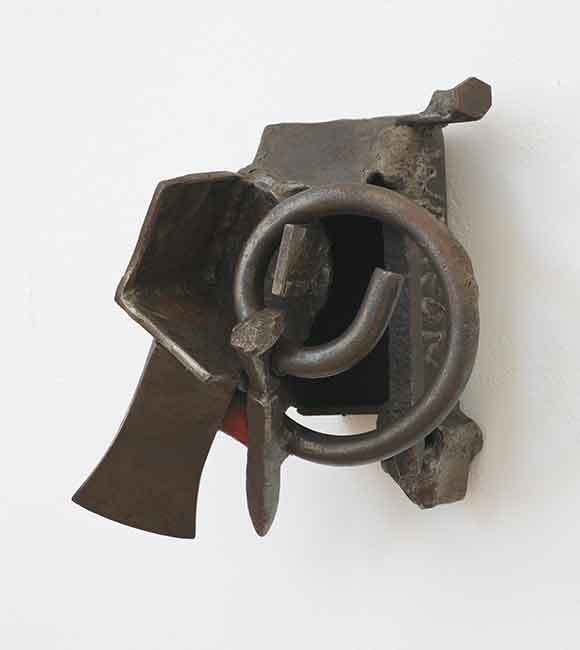A few weeks ago, I wrote about the African American abstract painter Sam Gilliam and his sometimes uneasy relationship with the artistic style of Black activists in the 1960s and 1970s. This week, I ran into some of the same issues while researching another work in the CFAM collection, in this case Weapon of Freedom, by the pioneering Black sculptor Melvin Edwards. Edwards, like many of his Black colleagues working in abstraction in the second half of the twentieth century, often escaped critical notice, caught in the double bind between Black cultural nationalism on the one hand and white disinterest on the other. Recently, however, scholars have begun to recognize Edwards and his colleagues for both their importance both politically and to the history of American modernism. Edwards—along with Gilliam and a number of others—was part of an important 2006 exhibition on Black abstraction at Harlem’s Studio Museum.1 And in 2015, he received a solo retrospective at the Nasher Sculpture Center in Dallas which has cemented his status as a major figure in American art since 1960.2

11 x 9 x 6 in., The Alfond Collection of Contemporary Art at Rollins College,
Gift of Barbara ’68 and Theodore ’68 Alfond, 2014.1.58.
© 2015 Melvin Edwards/Artists Rights Society (ARS), New York. Image courtesy of the artist.
Weapon of Freedom is one of a series of dozens of
works Edwards has made since 1963, all of which he calls his Lynch Fragments.
Edwards learned to weld while an art student in Los Angeles, and he quickly
started creating welded steel sculptures out of found scrap metal that both
explicitly and implicitly responded to the contemporary cultural and political
milieu, most notably his participation in protests against housing
discrimination and police violence.3
Avoiding explicitly imagery and other didactic means, Edwards instead relies on
the formal qualities of his sculptures, including their blending of familiar
and abstract forms; the twisting and pooling of the metal due to the welding;
and their small size, which requires bodily engagement from the viewer, to
evoke moods and feelings, which are often reinforced by the poetic and
evocative titles he gives the works.4 Weapon
of Freedom is a perfect example of this, as the axe head and railroad spike
clearly represent the threat of violence, both visited upon Black people by
racist vigilantes and, possibly, the readiness of Black people to resist such
violence. They also simultaneously evoke the tools of slavery—as do the chains
which frequently appear in the Lynch Fragments—and the work of enslaved
blacksmiths and African craftsmen.5 By
both evoking the ongoing possibility of racial violence and the history of
Black and African strength and creativity, Edwards is thus able to ally his
cutting-edge artistic style with a social message. His continued recognition is
perhaps the strongest proof yet that abstraction and Black activism do indeed
go together.
1 Kellie Jones and Studio Museum in Harlem, Energy Experimentation: Black Artists and Abstraction 1964-1980 ; Frank Bowling, Barbara Chase-Riboud, Ed Clark, Melvin Edwards, Fred Eversley, Sam Gilliam, Daniel LaRue Johnson, Tom Lloyd, Al Loving, Joe Overstreet, Howardena Pindell, Haywood Bill Rivers, Alma Thomas, Jack Whitten, William T. Williams ; The Studio Museum in Harlem, [April 5 – July 2, 2006 (New York, NY: The Studio Museum in Harlem, 2006).
2 Catherine Craft et al., Melvin Edwards: Five Decades ; [… Nasher Sculpture Center, Dallas, Texas, January 31 – May 10, 2015 ; the Zimmerli Art Museum at Rutgers University in New Brunswick, New Jersey, September 1, 2015 – January 3, 2016 ; and the Columbus Museum of Art, Columbus, Ohio, February 12 – May 8, 2016 (Dallas: Nasher Sculpture Center, 2015).
3 Lydie Diakhaté, “Melvin Edwards: The Poetic of the Blacksmith,” Wasafiri 30, no. 3 (2015): 69.
4 Celeste-Marie Bernier, Stick to the Skin: African American and Black British Art, 1965-2015, 2018, 78–79. Craft et al., Melvin Edwards, 14.
5 Bernier, Stick to the Skin, 78–79.

